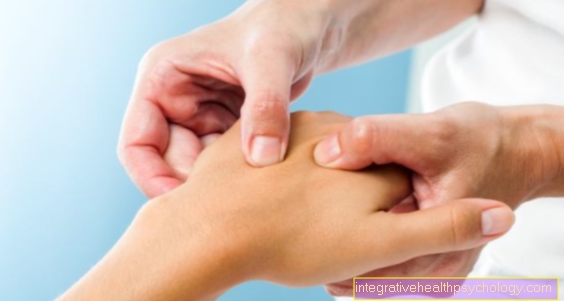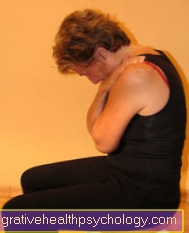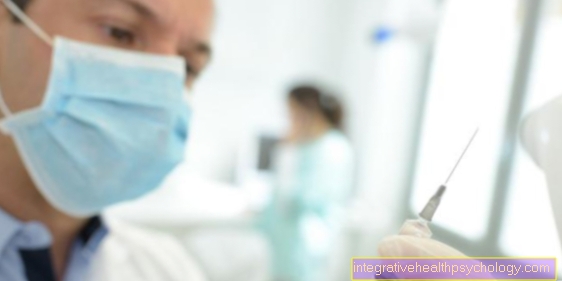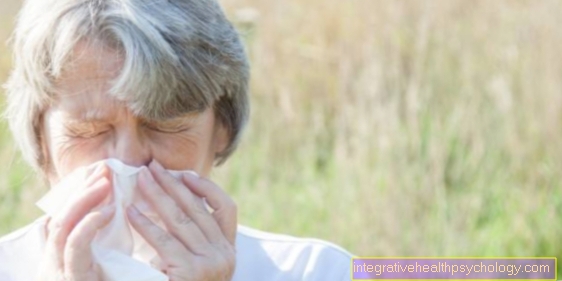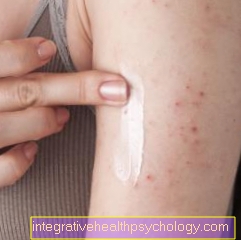Sweat gland inflammation
definition
The name sweat gland inflammation is actually not entirely appropriate, since the disease, also known as acne inversa, is actually an inflammation of the sebum glands. The armpits and genital area are particularly often affected.The duct of the sebum becomes blocked and the body's own material collects in the gland. Additional contamination with bacteria such as Staphylococcus aureus can then lead to inflammation with abscess formation. This also spreads to the sweat glands and is therefore eponymous. The disease is chronic and a genetic predisposition is suspected.
You can find detailed information on this on our website Acne inversa.

Inflammation of the sweat glands in the armpit
The armpits are one of the most common areas of the body affected by acne inversa. Women are more often affected in the armpits. The onset of the disease is often marked by the inflammation of the hair follicles. These are very prominent in the armpit region and therefore quickly affected. First of all, the ducts of the sebum glands clog and horny tissue accumulates. The tight lumps that form in the skin look like enlarged blackheads. Later large collections of pus form under the skin and the sweat glands become inflamed.
In the armpit area in particular, the local lymph nodes can swell clearly palpably and visibly, as there are many lymph nodes in this area. Swollen axillary lymph nodes are a normal immune system response to the ongoing inflammation. Both the purulent abscesses and the swollen lymph nodes can cause severe pain. Another peculiarity of the armpits is that colonization with the Staphylococcus aureus is more common there than in most other parts of the body. This germ is the cause of purulent abscesses and often settles in the already irritated glands, which then swell themselves and carry accumulations of pus.
Read our related topic: Inflammation of the armpit - how dangerous is it?
Sweat glands on the hands
There are also numerous sweat glands on the hands, which can clog and become inflamed as a result. However, the hands are not one of the most common areas of the body affected by inflammation of the sweat glands. Therefore, if you suspect sweat gland inflammation on the hand, you should delimit dyshidrosis (eczema on the hand), which has only retained its name for historical reasons. This disease manifests itself as itchy blisters on the palms of the hands and has no cause in the sweat glands.
Hand, mouth and foot disease, which manifests itself in a similar way, should also be considered in children.
Inflammation of the sweat glands on the feet
Sweat glands are located almost everywhere on the body and therefore also on the feet. The most common sweat gland infections, however, affect the sebum glands, which are much more common on very hairy skin than on the hands or feet.
In the case of small, itchy blisters or inflammation of the feet, other causes, such as dyshidrosis or hand-mouth-foot disease, should therefore also be checked. Fungal infections are also common in the feet and can also lead to inflammation of the skin.
Concomitant symptoms
In addition to the actual inflammation of the individual sweat glands, the disease is accompanied by other symptoms.
One of the main symptoms is pain. The blocked and inflamed sweat glands cause severe pain, which is provoked by tight clothing or movement. Local swelling of the lymph nodes can also occur. Many lymph nodes are located in the groin and armpits. These react with the ongoing inflammation and are a sign that the immune system is actively fighting the inflammation. The swollen lymph nodes can also be painful. The inflamed areas also release a foul-smelling, purulent secretion. In the case of an already chronic course, scars can be seen in addition to the acute inflammation, which indicate areas of inflammation that have already healed.
In extreme cases, blood poisoning (sepsis) can be triggered by the bacteria entering the bloodstream. This manifests itself in fever, loss of consciousness, high pulse and low blood pressure and represents a life-threatening emergency situation. Due to the stigma, those affected often have to struggle with depression.
Pain from an inflammation of the sweat glands
Inflammation is almost always accompanied by an increased sensation of pain. The affected area has increased blood flow and is swollen. In addition, the predominantly affected areas of the body are sensitive skin areas, such as the armpits and the genital area. The pain can be intensified by touch, pressure and tight clothing. Because of the localization, normal running is often very painful for those affected. Swollen lymph nodes can also be painful when there is inflammation.
Swelling of the lymph nodes
Swollen lymph nodes are almost always a sign that the immune system is actively fighting a pathogen. Local lymph nodes are located in the drainage area of a certain region of the body. If an inflammation occurs in the respective body region, the immune system is activated and defense cells are sent to the lymph nodes. This swelling of the local lymph nodes can be painful. The lymph nodes can be felt through the skin and are often visible. However, the lymph node itself is not the site of inflammation.
The therapy of sweat gland inflammation
In the early stages of the disease, conservative therapy may be sufficient. There are various drugs for this. Control of inflammation can sometimes be achieved with antibiotics. These must be determined by a microbiological laboratory as there are many resistant bacteria. So-called antiandrogens, i.e. drugs against male sex hormones, can also be helpful, as these hormones increase sebum production. The still young group of biologicals can also work against inflammation.
Various antibacterial lotions and ointments can be used locally. Some of these also contain antibiotics, such as clindamycin. In the case of advanced inflammation with abscesses, surgical therapy is often the only option. The inflamed and damaged skin areas are completely removed and the abscesses peeled off. Split skin treatment is sometimes necessary for larger areas. Here, healthy skin from other areas of the body is used to close the wound. The acne inversa is not completely curable. The inflammation usually occurs repeatedly and those affected repeatedly need therapy, including operations.
Treat the sweat gland inflammation with ointment
Various ointments or lotions can be used for local treatment. Some have a purely antibacterial effect and thereby limit the infection. In other ointments there is an antibiotic that actively fights the pathogen, mostly Staphylococcus aureus. A therapy is always made up of several components. The diseases cannot be treated exclusively with ointments.
Home remedies for sweat glands
As with many diseases, there are a number of home remedies for sweat gland inflammation. The effect is sometimes not entirely undisputed. One possibility is washcloths that are bathed in chamomile tea, as chamomile has anti-inflammatory properties. A sauna session is also mentioned more often, as the warm air opens the pores of the skin and so the pus should be able to drain away more easily. Black tea is also said to have antibacterial ingredients and it is therefore advisable to place a used tea bag on the affected area.
You might also be interested in: Home remedies for acne
Homeopathy for inflammation of the sweat glands
Some remedies from homeopathy are also mentioned which are supposed to help with inflammation of the sweat glands. One possibility can be thuja, which is supposed to limit the skin lesions. Hepar Sulfuris Calcareum and Belladonna are also said to reduce pus formation. However, homeopaths also recommend seeing a doctor if you have pronounced sweat gland inflammation or recurring symptoms.
Acne Inversa is a serious disease in which only early conventional medical therapy can prevent long-term effects.
Duration of sweat gland inflammation
The individual sweat gland inflammation can subside after a few days treated. However, those affected often suffer from recurrent inflammation and lesions. Acne Inversa is a chronic condition for which there is no permanent cure. The duration of the episode may vary depending on the stage at which treatment was started. Lighter inflammations are short-lived, while larger, purulent abscesses can often only be removed surgically. Wound healing after surgical removal can take a few weeks, as the wound remains open for a long time, especially with split skin therapies.
Causes of sweat gland inflammation
The acute cause of sweat gland inflammation is the blockage of a sebum gland in which the body's own material accumulates. Basically, however, it is assumed that acne inversa is based on a genetic disease. There are numerous factors that are suspected to be either triggers or amplifiers of the disease. One of the factors is tobacco use. About four in five Acne Inversa patients are smokers. This connection is attributed to the increased growth of the bacterium Staphylococcus aureus in smokers.
Furthermore, male sex hormones are an intensifying factor, as they lead to increased sebum production. Diabetes is also cited as a risk factor because these people have a weakened immune system and thus more easily get bacterial infections. This also includes all other causes of a weak immune system. Overweight people also develop sweat gland inflammation more often, as a moist, warm environment under skin folds promotes this. Bacteria can also penetrate damaged skin more easily, and wearing too tight clothing is sufficient to cause skin irritation.
So no specific reason for a sweat gland disease can be given. Rather, it is a collection of risk factors.
Read more on the subject at: Acne inversa
diagnosis
The diagnosis is usually made clinically on the basis of symptoms. It is important to distinguish the relatively unspecific symptoms from other possible diseases. Individual abscesses, allergies and infectious diseases should be mentioned here. In the case of chronic acne inversa, the final diagnosis can only be confirmed with a tissue sample. Since the disease does not occur often, those affected are often misdiagnosed at first. It is typical of the disease that the inflammation recurs and does not go away after treatment.



